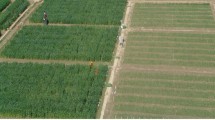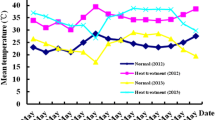Abstract
Field experiments for evaluating heat tolerance-related physiological traits were conducted for two consecutive years using a mapping population of recombinant inbred lines (RILs) from the cross RAJ4014/WH730. Chlorophyll content (Chl) and chlorophyll fluorescence (CFL) were recorded under timely sown (TS) and late sown (LS) conditions. Late sowing exposes the terminal stage of plants to high temperature stress. Pooled analysis showed that CFL and Chl differed significantly under TS and LS conditions. The mean value of CFL (Fv/Fm) and Chl under both timely and late sown conditions were used as physiological traits for association with markers. Regression analysis revealed significant association of microsatellite markers viz., Xpsp3094 and Xgwm131 with coefficients of determination (R 2) values for CFL (Fv/Fm) and Chl as 12 and 8 %, respectively. The correlation between thousand grain weight (TGW) with Chl and CFL were 14 and 7 % and correlation between grain wt./spike with Chl and CFL were 15 and 8 %, respectively. The genotypes showing tolerance to terminal heat stress as manifested by low heat susceptibility index (HSI = 0.43) for thousand grain weight, were also found having very low Chl, HSI (−0.52). These results suggest that these physiological traits may be used as a secondary character for screening heat-tolerant genotypes.



Similar content being viewed by others
Abbreviations
- Chl:
-
Chlorophyll content
- CFL:
-
Chlorophyll fluorescence
- TGW:
-
Thousand grain weight
- SSR:
-
Simple sequence repeat
- RIL:
-
Recombinant inbred lines
- Fv/Fm:
-
Variable fluorescence/maximal fluorescence
- HSI:
-
Heat susceptibility index
- QTLs:
-
Quantitative trait loci
- GFD:
-
Grain filling duration
- DPA:
-
Days to post anthesis
References
Al-Khatib K, Paulsen GM (1990) Photosynthesis and productivity during high temperature stress of wheat genotypes from major world regions. Crop Sci 30:1127–1132
Anonymous (2011) Annual Report 2010–11, Directorate of Wheat Research, Karnal-132001 (India). pp: 18
Blum A, Ebercon A (1981) Cell membrane stability as a measure of drought and heat tolerance in wheat. Crop Sci 21:43–47
Blum A (1986) The effect of heat stress on wheat leaf and ear photosynthesis. J Exp Bot 37:111–118
Blum A (1988) Plant breeding for stress environments. CRC Press, Boca Raton, p 232
Blum A, Shpiler L, Golan G, Mayer J (1989) Yield stability and canopy temperature of wheat genotypes under drought stress. Field Crop Res 22:289–296
Ciuca M, Petcu E (2009) SSR markers associated with membrane stability in wheat (Triticum aestivum L.). Rom Agric Res 26:21–24
Cossani CM, Reynolds MP (2012) Physiological traits for improving heat tolerance in wheat. Plant Physiol 160:1710–1718
Dhanda SS, Munjal R (2012) Heat tolerance in relation to acquired thermotolerance for membrane lipids in bread wheat. Field Crops Res 135:30–37
Emerson R, Arnold W (1932) The photochemical reaction in photosynthesis. J Gen Physiol 16:191–205
Fischer RA, Maurer R (1978) Drought resistance in spring wheat cultivars. I. Grain yield responses in spring wheat. Aust J Agric Sci 29:892–912
Hede A, Skovmand RB, Reynolds MP, Crossa J, Vilhelmsen AL, Stølen O (1999) Evaluating genetic diversity for heat tolerance traits in Mexican wheat landraces. Genet Resour Crop Evol 46:37–45
Hillier W, Babcock GT (2001) Photosynthetic reaction centres. Plant Physiol 125:33–37
Jiang GH, He YQ, Xu CG, Li XH, Zhang Q (2004) The genetic basis of stay-green in rice analyzed in population of dihybrid lines derived from indica by japonica cross. Theor Appl Genet 108:688–698
Kate M, Giles NJ (2000) Chlorophyll fluorescence. J Exp Bot 51(345):659–668
Krause GH, Weis E (1991) Chlorophyll fluorescence and photosynthesis: the basic. Annu Rev Plant Physiol Plant Mol Biol 42:313–349
Kumar U, Joshi AK, Kumari M, Paliwal R, Kumar S, Röder M (2010) Identification of QTLs for stay green trait in wheat (Triticum aestivum L.) in the ‘Chirya 3’ 3 ‘Sonalika’ population. Euphy 174:437–445
Kundu S, Singh C, Shoran J, Singh SS (2010) An update on released wheat varieties and registered genetic stocks (Triticum L.). Technical Bulletin No.13, Directorate of Wheat Research, Karnal-132001 (India). pp: 34
Li R, Guo P, Baum M, Grande S, Ceccarelli S (2006) Evaluation of chlorophyll content and fluorescence parameters as indicators of drought tolerance in barley. Agric Sci China 5:751–757
Moffatt JM, Sears G, Cox TS, Paulsen GM (1990) Wheat high temperature tolerance during reproductive growth. I. Evaluation by chlorophyll fluorescence. Crop Sci 30:881–885
Nachit MM, Monneveux P, Araus JL, Sorrells ME (1998) Relationship of dryland productivity and drought tolerance with some molecular markers for possible MAS in durum (T. turgidum L. var.durum). CIHEAM Opt Mediterr 1:203–206
O’Neill PM, Shanahan JF, Schepers JS, Caldwell B (2004) Agronomic responses of corn hybrids from different areas to deficit and adequate level of water and nitrogen. Agron J 96:1660–1667
Ortiz R, Sayre KD, Govaerts B, Gupta R, Subbarao GV, Ban T, Hodson D, Dixon JM, Ortiz-Monasterio JI, Reynolds M (2008) Climate change: can wheat beat the heat. Agric Ecosyst Environ 126:46–58
Quarrie SA, Steed A, Semikhodski A, Lebreton C, Calestani C, Clarkson DT, Tuberosa R, Sanguineti MC, Melchiorre R, Prioul JL (1995) Identification of quantitative trait loci regulating water- and nitrogen-use efficiency in wheat. In: Proceedings of STRESSNET meeting, Salsomaggiore, Sept 1995. European Commission, Luxembourg, pp 175–180
Quarrie SA, Steed A, Calestani C, Semikhodskii A, Lebreton C, Chinoy C, Steele N, Pljevljakusic D, Waterman E, Weyen J, Schondelmaier J, Habash DZ, Farmer P, Saker L, Clarkson DT, Abugalieva A, Yessimbekova M, Turuspekov Y, Abugalieva S, Tuberosa R, Sanguineti MC, Hollington PA, Aragues R, Royo A, Dodig D (2005) A high-density genetic map of hexaploid wheat (Triticum aestivum L.) from the cross Chinese Spring X SQ1 and its use to compare QTLs for grain yield across a range of environments. Theor Appl Genet 110:865–880
Quarrie SA, Pekic Quarrie S, Radosevic R, Rancic D, Kaminska A, Barnes JD, Leverington M, Ceoloni C, Dodig D (2006) Dissecting a wheat QTL for yield present in a range of environments: from the QTL to candidate genes. J Exp Bot 57:2627–2637
Reynolds MP, Balota M, Delgado MIB, Amani J, Fischer RA (1994) Physiological and morphological traits associated with spring wheat yield under hot, irrigated conditions. Aust J Plant Physiol 21:717–730
Reynolds MP, Nagarajan S, Razzaque MA, Ageeb OAA (1997) Using canopy temperature depression to select for yield potential of wheat in heat-stressed environments. Wheat Special Report No. 42. Mexico, D.F.: CIMMYT
Roder MS, Korzun V, Wendehake K, Plaschke J, Tixier M, Leroy P, Ganal MW (1998) A microsatellite map of wheat. Genet 149:2007–2023
Saghai-Maroof MA, Soliman KM, Jorgensen RA, Allard RW (1984) Ribosomal DNA spacer length polymorphisms in barley: Mendelian inheritance, chromosomal location, and population dynamics. Proc Natl Acad Sci U S A 81:8014–8018
Saint Pierre C, Crossa J, Manes Y, Reynolds MP (2010) Gene action of canopy temperature in bread wheat under diverse environments. Theor Appl Genet 120:1107–1117
Tuberosa R, Salvi S (2006) Genomics-based approaches to improve drought tolerance of crops. Trends Plant Sci 11(8):405–412
Vijayalakshmi K, Fritz A, Paulsen G, Bai G, Pandravada S, Gill B (2010) Modeling and mapping QTL for senescence-related traits in winter wheat under high temperature. Mol Breed 26:163–175
Wang FH, Wang GX, Li XY, Huang JL, Zheng JK (2008) Heredity, physiology and mapping of a chlorophyll content gene of rice (Oryza sativa L.). J Plant Physiol 165:324–330
Wardlaw IF, Sofield I, Cartwright PM (1980) Factors limiting the rate of dry matter accumulation in the grain of wheat grown at high temperature. Aust J Plant Physiol 7:387–400
Zadoks JC, Chang TT, Konzak CF (1974) A decimal code for the growth stages of cereals. Weed Res 14:415–421
Acknowledgments
The authors acknowledge the ICAR for financial support for carrying out the work under NPTC: Functional Genomics in wheat project.
Author information
Authors and Affiliations
Corresponding author
Rights and permissions
About this article
Cite this article
Pandey, G.C., Mamrutha, H.M., Tiwari, R. et al. Physiological traits associated with heat tolerance in bread wheat (Triticum aestivum L.). Physiol Mol Biol Plants 21, 93–99 (2015). https://doi.org/10.1007/s12298-014-0267-x
Received:
Revised:
Accepted:
Published:
Issue Date:
DOI: https://doi.org/10.1007/s12298-014-0267-x




